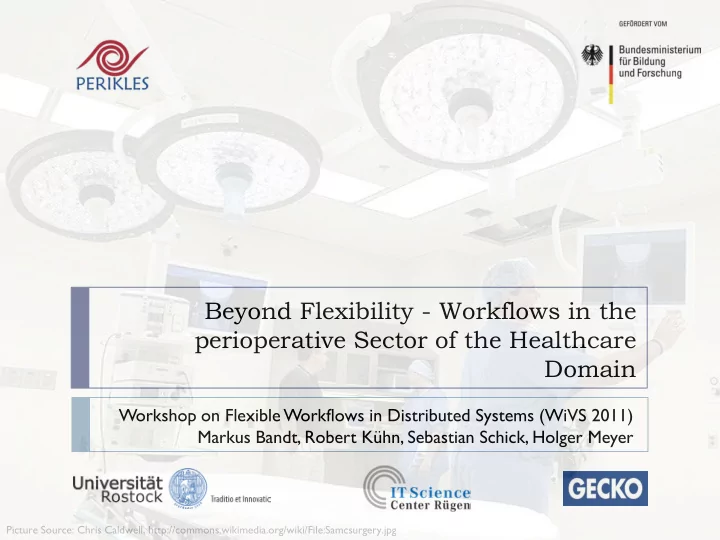

Beyond Flexibility - Workflows in the perioperative Sector of the Healthcare Domain Workshop on Flexible Workflows in Distributed Systems (WiVS 2011) Markus Bandt, Robert Kühn, Sebastian Schick, Holger Meyer Picture Source: Chris Caldwell, http://commons.wikimedia.org/wiki/File:Samcsurgery.jpg
PERIKLES – the Project German acronym for “Unterstützung peri operativer klinischer Prozesse durch k ooperierende f le xible Workflows und AutoID- S ensorsysteme” Executive Partners: Rostock University, ITSC, Gecko Associated Partners: UMC Rostock KMG Klinik Güstrow Hetzelstift Neustadt (Weinstraße) UMC Köln QUT Brisbane – BPM Group 2
PERIKLES – Goals Support of perioperative clinical processes by cooperating flexible workflows and auto ID sensor systems workflow-based assistance system to support the operating room management in a hospital simplify common tasks Scheduling Coordinating Communication Tracking (process visualisation, statistical analysis) 3
Perioperative Process in Detail perioperative process in a hospital includes all clinical workflows from admission of the patient on the ward, about the surgery, until the patient can leave hospital Core process at the day of surgical treatment „Slide show“ 4
Perioperative Process – Inward Transfer 5
Perioperative Process – Induction 6
Perioperative Process – Anaesthesia 7
Perioperative Process – Surgery 8
Perioperative Process – Reversal 9
Perioperative Process – Recovery 10
Perioperative Process – Snapshot 11
Extended Perioperative Process 12
The Need for Flexibility Why is flexibility so important in the health care sector? Re-scheduling of a single task (e.g. change of diagnosis / method) Predictable emergency situations (e.g. emergency treatment, transplantation treatment) Unpredictable situations (demand of additional or sudden lack of ressources, deterioration of patients conditions, disaster situations) etc. 13
Structural Perspective on Flexibility What kind of (flexible) activities are prevalent here? Parallel activities Partially ordered activities Optional activities Alternative activities Synchronisation of activities Cancellation of activities 14
Flexibility Concepts – Summary The patterns in the table refer to the definitions of the Workflow Patterns Initiative ( http://www.workflowpatterns.com/ ). 15
Implementation – YAWL YAWL asWfMS of choice Open Source Framework with formal foundation Well documented Extendable through WS-Interface Good, productive contact with developers 16
Example: Induction /partial order Legend (YAWL Elements) : 17
Example: Re-scheduling / expected exception 18
Conclusion YAWL as tracking system Some flexibility concepts limited Stability and maintenance costs vs. Flexibilty Successful evaluation with stakeholders To-do: Evaluation of combining different WfMS to gather advantages (incl. cost benefit analysis) Handling unpredictable exceptions / ad-hoc processing 19
Thank You English Thai Gracias Russian Spanish Obrigado Traditional Chinese Brazilian Portuguese Arabic Danke German Grazie Merci Simplified Chinese Italian French Japanese Korean
Publications connected to the project “HOPS zur Modellierung flexibler, klinischer Prozesse als Grundlage eines workflowbasierten Assistenzsystems”, R. Kühn et al., USEWARE 2010 “Modelling Complex Resource Requirements in Business Process Management Systems”, C. Ouyang et al., ACIS 2010 “Beyond Flow of Control – Supporting Transactional Workflows Accessing External Data Sources”, S. Schick et al., submitted for review 21
Recommend
More recommend